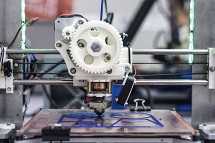Is making new? How does it work best? A SXSWedu panel explores concepts around making.
 Making, maker spaces, and maker labs have dominated educational discussions in recent months. How can schools create maker spaces for students? How can they link maker technology and maker activities to core curriculum?
Making, maker spaces, and maker labs have dominated educational discussions in recent months. How can schools create maker spaces for students? How can they link maker technology and maker activities to core curriculum?
Though terms like “maker” and “making” might be the buzzwords du jour, the concept itself is far from new.
During SXSWedu, a panel of educators and industry experts touched on important concepts and practices around making.
As the discussion unfolded, panelist Paulo Blikstein, an assistant professor at Stanford University’s School of Education and Computer Science Department, revealed that maker spaces are far from new.
Next page: Four myths about making
1. Making is new
Making is not new, though the term “making” might be new. “There’s a long tradition in constructionist learning,” Blikstein said. “There is lots written about making, just not with that label.” Decades of research focus on making, using terms such as constructionist or constructivist learning.
2. All kids are hackers
All students are not innate hackers. Not every student will emerge from a maker lab having created something innovative or unique completely unguided or without educator help. Some will, but most won’t, Blikstein said.
“When we start talking about how every kid should be a hacker, it might sound really nice, but that’s not how the average student learns,” he said. “The average student needs some sort of structure or facilitation.”
Blikstein and colleagues approached this concept from two angles. First, they conducted short workshops where students of all ability levels entered the workshop and were instructed to make something without facilitation. More experienced students ended the workshop having created something, but the novice students quickly lost confidence. In fact, this approach reinforced to the novice students that they couldn’t make or create.
“When we changed the approach and had people there facilitating and helping the students, things changed dramatically and the students became more autonomous and started to learn by themselves,” he said. “This idea of just throwing kids in a lab and hoping for the best doesn’t work. It works against us. The sink-or-swim culture of hacker spaces just doesn’t work in schools with students.”
3. Making is about getting kids into STEM careers
“We don’t do physical education in schools because we need more athletes. We don’t teach music because we have a shortage of musicians. We teach those things because they’re important cultural artifacts and fields of knowledge,” Blikstein said.
“The same should be for engineering, science, and programming. We don’t want to use this argument that it’s all about competing with China. It’s more about exposing kids to powerful ideas and helping create more sophisticated thinkers.”
4. Diversity will happen by itself
“We need to actively do something about this,” Blikstein said.
Many maker fairs and making opportunities are attended by highly-educated families with disposable incomes, whereas student from low socioeconomic backgrounds might have working parents who can’t take them to those activities, might have family members who don’t understand the importance of making and maker spaces, or might not be able to afford participation fees or associated costs.
Many high-income schools have easy access to maker tools, and have the budget to support making, whereas schools in low-income areas don’t always have the same opportunity, he noted.
“It isn’t just about income–it’s about gender and culture. We need to diversify the kinds of projects people are doing,” he said.
- Friday 5: College and career readiness - April 12, 2024
- Cybersecurity: eSN Innovation Roundtable - April 11, 2024
- School-home communication remains a challenge for many districts - April 10, 2024
